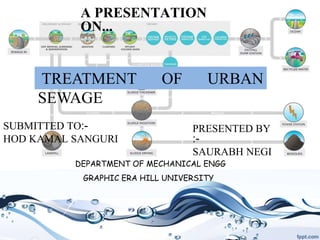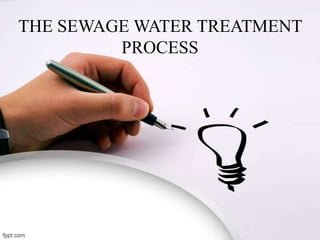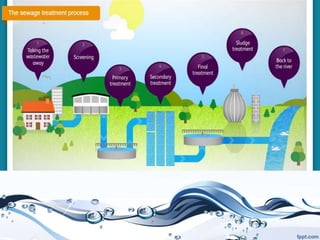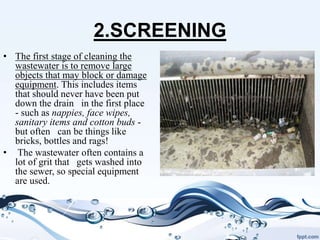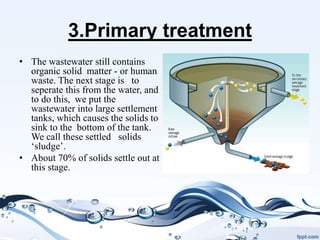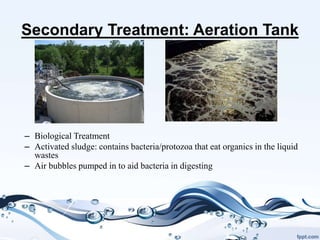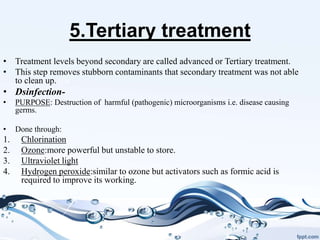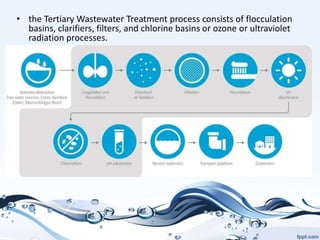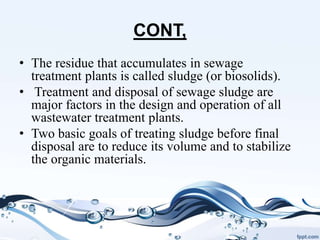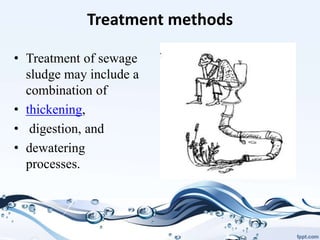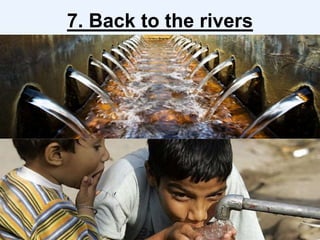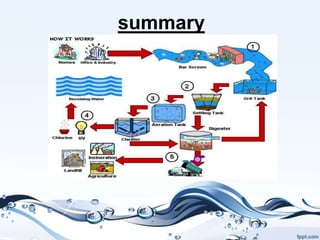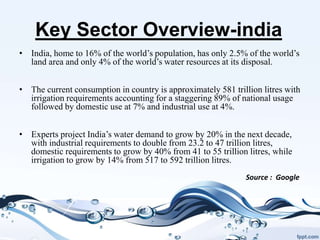treatment of urban sewage
- 1. A PRESENTATION ON... TREATMENT OF URBAN SEWAGE SUBMITTED TO:- HOD KAMAL SANGURI PRESENTED BY :- SAURABH NEGI DEPARTMENT OF MECHANICAL ENGG GRAPHIC ERA HILL UNIVERSITY
- 2. THE SEWAGE WATER TREATMENT PROCESS
- 4. 1.Taking the wastewater away • The wastewater goes down the drain and into a pipe, which takes it to a larger sewer pipe under the road. • The sewer then joins our network of other sewers and takes the wastewater to a sewage treatment works.
- 5. 2.SCREENING • The first stage of cleaning the wastewater is to remove large objects that may block or damage equipment. This includes items that should never have been put down the drain in the first place - such as nappies, face wipes, sanitary items and cotton buds - but often can be things like bricks, bottles and rags! • The wastewater often contains a lot of grit that gets washed into the sewer, so special equipment are used.
- 6. 3.Primary treatment • The wastewater still contains organic solid matter - or human waste. The next stage is to seperate this from the water, and to do this, we put the wastewater into large settlement tanks, which causes the solids to sink to the bottom of the tank. We call these settled solids ‘sludge’. • About 70% of solids settle out at this stage.
- 7. 4.Secondary treatment • Although the visible bits of sludge have been removed, we have to ensure that the smaller and sometimes invisible nasty bugs are also taken out. • Utilizes biological treatment processes • removes dissolved colloidal and organic matter from waste water. • microorganisms convert nonsettleable solids to settleable solids. • Ex…. • Bacteria and protozoa
- 8. Secondary Treatment: Aeration Tank – Biological Treatment – Activated sludge: contains bacteria/protozoa that eat organics in the liquid wastes – Air bubbles pumped in to aid bacteria in digesting
- 9. Secondary Treatment: Final Clarifiers – Microbes fall to bottom and most get recycled back into aeration tank to work on more waste – Any excess microbes are removed and sent to solids treatment.
- 10. 5.Tertiary treatment • Treatment levels beyond secondary are called advanced or Tertiary treatment. • This step removes stubborn contaminants that secondary treatment was not able to clean up. (Di • Dsinfection- • PURPOSE: Destruction of harmful (pathogenic) microorganisms i.e. disease causing germs. • Done through: 1. Chlorination 2. Ozone:more powerful but unstable to store. 3. Ultraviolet light 4. Hydrogen peroxide:similar to ozone but activators such as formic acid is required to improve its working.
- 11. • the Tertiary Wastewater Treatment process consists of flocculation basins, clarifiers, filters, and chlorine basins or ozone or ultraviolet radiation processes.
- 12. 6.SLUDGE TREATMENT AND DISPOSAL
- 13. CONT, • The residue that accumulates in sewage treatment plants is called sludge (or biosolids). • Treatment and disposal of sewage sludge are major factors in the design and operation of all wastewater treatment plants. • Two basic goals of treating sludge before final disposal are to reduce its volume and to stabilize the organic materials.
- 14. Treatment methods • Treatment of sewage sludge may include a combination of • thickening, • digestion, and • dewatering processes.
- 15. Treatment methods • Thickening- • Thickening is usually the first step in sludge treatment because it is impractical to handle thin sludge, a slurry of solids suspended in water. • Digestion- • Sludge digestion is a biological process in which organic solids are decomposed into stable substances. Digestion reduces the total mass of solids, destroys pathogens, and makes it easier to dewater or dry the sludge. • Dewatering- • Digested sewage sludge is usually dewatered before disposal. Dewatered sludge still contains a significant amount of water—often as much as 70 percent—but, even with that moisture content, sludge no longer behaves as a liquid and can be handled as a solid material.
- 16. 7. Back to the rivers
- 17. summary
- 18. Why to treat sewage wastewater?
- 19. Key Sector Overview-india • India, home to 16% of the world’s population, has only 2.5% of the world’s land area and only 4% of the world’s water resources at its disposal. • The current consumption in country is approximately 581 trillion litres with irrigation requirements accounting for a staggering 89% of national usage followed by domestic use at 7% and industrial use at 4%. • Experts project India’s water demand to grow by 20% in the next decade, with industrial requirements to double from 23.2 to 47 trillion litres, domestic requirements to grow by 40% from 41 to 55 trillion litres, while irrigation to grow by 14% from 517 to 592 trillion litres. Source : Google
